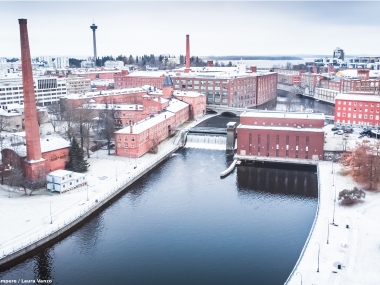Non-combustion-based district heating is a key factor of carbon neutrality
Edited on
14 June 2022Heating is a major emission source in Finland and other Nordic countries, which is particularly pronounced at the city level. Large temperature variations and even below -30°C winter temperatures cause great variation also in the heat demand. To these conditions, many Nordic cities seek solutions with a district heating system. So does Tampere and the city-owned Tampere Energy Company.

Tampere Energy company : an important player in the city
Tampere Energy company can be compared to a large-scale energy community providing heat and electricity to citizens. The company is owned and guided by the City of Tampere and it provides revenue for the city. In 2020, Tampere Energy company used 82 % of domestic fuel in its heat and power production. About 50 % was produced with renewable energy sources and there were 1520 solar panels in Tarastenjärvi solar park. The company has reduced 57 % of CO2 emissions since 2010 and is committed to reducing emissions from heat production by almost 90 % between 2015 and 2030.
Finland – a pioneer in district heating
Along with Denmark, Finland is a world leader in district heating. A temperature of minus 5°C is the optimum ambient temperature for the commercial performance of the system. Tampere’s district heating company was established in 1964. The District heating network is 600 km long and has 6,000 connections and 200,000 customers. Ninety percent of Tampere’s inhabitants can access the district heating system. The city is looking at developing a smart district heating network in the future. Heating and associated emissions have been a priority thus far as have emissions from housing.
In 2021, Tampere Energy company conducted a study about non-combustion-based district heating and possible actions towards smart and carbon neutral energy system for the city council. The study includes both technological reviews and alternative scenarios but the final road towards carbon neutrality is still affected by multiple factors and can be specified only during the process. The most potential technologies for combustion-free and carbon-negative district heating production in Tampere are electric boilers, heat pumps, and carbon dioxide recovery. The non-combustion and carbon-negative plan is supposed to be fulfilled in 2040.
District heating is the most sustainable heating system
The price of district heating is based on how to ensure the heating throughout the city during the coldest time of the year. The heating challenge really exists only a couple of weeks or months a year but the price of district heating must remain reasonable also at that time in order to be a realistic choice for the consumer. The social dimension of energy access means, among other things, that people must have an equal access to affordable and high-quality heating energy.
District heating system is the fastest way to react to the changes in the heating need of the city. This makes it also the most resource-efficient heating system and therefore the best in the fight against climate change. The strengths of district heating include the centralized implementation of changes in the mode of production, the recovery of waste heat, the equalization of consumption peaks, the versatile utilization of energy sources, and the security of supply of the system.
Besides the technological advantages, at the end of the day district heating is a service produced for the citizens by a public-owned company not aiming only at profit but also the most sustainable and customer friendly energy production.
Submitted by Hélène Mazaleyrat on
